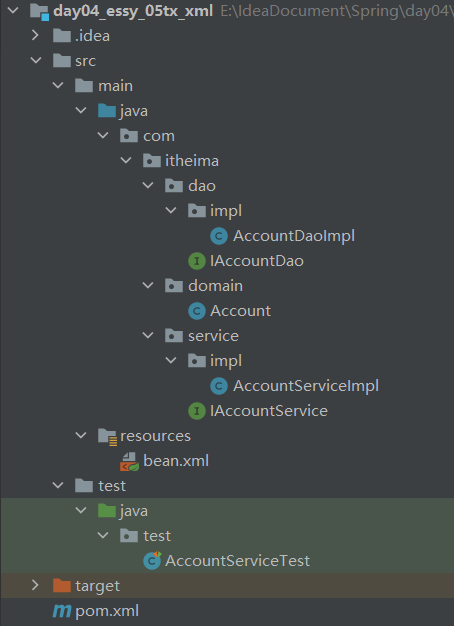Spring中的事务控制知识总结
一、环境准备
为了演示 Spring 中的事务控制,我们创建一个空项目,项目目录如下:

导入依赖:
<dependencies> <dependency> <groupId>org.springframework</groupId> <artifactId>spring-context</artifactId> <version>5.0.2.RELEASE</version> </dependency> <dependency> <groupId>org.springframework</groupId> <artifactId>spring-jdbc</artifactId> <version>5.0.2.RELEASE</version> </dependency> <dependency> <groupId>org.springframework</groupId> <artifactId>spring-tx</artifactId> <version>5.0.2.RELEASE</version> </dependency> <dependency> <groupId>mysql</groupId> <artifactId>mysql-connector-java</artifactId> <version>5.1.6</version> </dependency> <dependency> <groupId>org.aspectj</groupId> <artifactId>aspectjweaver</artifactId> <version>1.8.7</version> </dependency> <dependency> <groupId>junit</groupId> <artifactId>junit</artifactId> <version>4.12</version> </dependency> <dependency> <groupId>org.springframework</groupId> <artifactId>spring-test</artifactId> <version>5.0.2.RELEASE</version> </dependency> </dependencies>
业务层及其实现类:
/**
* 账户的业务层接口
*/
public interface IAccountService {
void transfer(String sourceName, String targetName, Float money);
}
/**
* 转账的业务层实现类
*/
public class AccountServiceImpl implements IAccountService {
private IAccountDao accountDao;
public void setAccountDao(IAccountDao accountDao) {
this.accountDao = accountDao;
}
/**
* 转账
* @param sourceName 转出账户名称
* @param targetName 转入账户名称
* @param money 转账金额
*/
public void transfer(String sourceName, String targetName, Float money) {
//1. 根据名称查询转出账户
Account source = accountDao.findAccountByName(sourceName);// 1. 第一次事务,提交
//2. 根据名称查询转入账户
Account target = accountDao.findAccountByName(targetName);// 2. 第二次事务提交
//3. 转出账户减钱
source.setMoney(source.getMoney()-money);
//4. 转入账户加钱
target.setMoney(target.getMoney()+money);
//5. 更新转出账户
accountDao.updateAccount(source); // 3. 第三次事务提交
int i = 1/0; // 4. 报异常
//6. 更新转入账户
accountDao.updateAccount(target); // 5. 事务不执行
}
}
账户持久层及其接口:
/**
* 账户的持久层接口
*/
public interface IAccountDao {
/**
* 根据Id查询账户
* @param accountId
* @return
*/
Account findAccountById(Integer accountId);
/**
* 根据名称查询账户
* @param accountName
* @return
*/
Account findAccountByName(String accountName);
/**
* 更新账户
* @param account
*/
void updateAccount(Account account);
}
/**
* 账户的持久层实现类
*/
public class AccountDaoImpl extends JdbcDaoSupport implements IAccountDao {
public Account findAccountById(Integer accountId) {
List<Account> accounts = super.getJdbcTemplate().query("select * from account where id = ?",new BeanPropertyRowMapper<Account>(Account.class),accountId);
return accounts.isEmpty()?null:accounts.get(0);
}
public Account findAccountByName(String accountName) {
List<Account> accounts = super.getJdbcTemplate().query("select * from account where name = ?",new BeanPropertyRowMapper<Account>(Account.class),accountName);
if(accounts.isEmpty()){
return null;
}
if(accounts.size()>1){
throw new RuntimeException("结果集不唯一");
}
return accounts.get(0);
}
public void updateAccount(Account account) {
super.getJdbcTemplate().update("update account set name=?,money=? where id=?",account.getName(),account.getMoney(),account.getId());
}
}
这里配置的是 Spring 内置数据源,当然也可以应用 JdbcTemplate。
bean.xml:
<?xml version="1.0" encoding="UTF-8"?>
<beans xmlns="http://www.springframework.org/schema/beans"
xmlns:xsi="http://www.w3.org/2001/XMLSchema-instance"
xmlns:aop="http://www.springframework.org/schema/aop"
xmlns:tx="http://www.springframework.org/schema/tx"
xsi:schemaLocation="
http://www.springframework.org/schema/beans
http://www.springframework.org/schema/beans/spring-beans.xsd
http://www.springframework.org/schema/tx
http://www.springframework.org/schema/tx/spring-tx.xsd
http://www.springframework.org/schema/aop
http://www.springframework.org/schema/aop/spring-aop.xsd">
<!--配置业务层-->
<bean id="accountService" class="com.itheima.service.impl.AccountServiceImpl">
<property name="accountDao" ref="accountDao"></property>
</bean>
<!-- 配置账户的持久层-->
<bean id="accountDao" class="com.itheima.dao.impl.AccountDaoImpl">
<property name="dataSource" ref="dataSource"></property>
</bean>
<!-- 配置数据源-->
<bean id="dataSource" class="org.springframework.jdbc.datasource.DriverManagerDataSource">
<property name="driverClassName" value="com.mysql.jdbc.Driver"></property>
<property name="url" value="jdbc:mysql://localhost:3306/springdb"></property>
<property name="username" value="root"></property>
<property name="password" value="000000"></property>
</bean>
</beans>
二、基于 XML 的事务控制
Spring 中基于 xml 的声明式事务控制配置步骤
1.配置事务管理器
<!--配置事务管理器--> <bean id="transactionManager" class="org.springframework.jdbc.datasource.DataSourceTransactionManager"></bean>
2.配置事务的通知 (需要导入事务的约束 tx 和 aop 的名称空间和约束)
使用 tx:advice 标签配置事务通知
属性:
id:给事务通知起一个唯一标识
transaction-manager:给事务通知提供一个事务管理器引用
<!--配置事务的通知--> <tx:advice id="txAdvice" transaction-manager="transactionManager"></tx:advice>
3.配置AOP的通用切入点表达式
<!--配置AOP的通用切入点表达式--> <aop:config> <aop:pointcut id="pt1" expression="execution(* com.itheima.service.*.*(..))"></aop:pointcut> </aop:config>
4.建立事务通知 与 切入点表达式的对应关系
<!--配置AOP的通用切入点表达式--> <aop:config> <aop:pointcut id="pt1" expression="execution(* com.itheima.service.*.*(..))"></aop:pointcut> <aop:advisor advice-ref="txAdvice" pointcut-ref="pt1"></aop:advisor> </aop:config>
5.配置事务的属性
在事务的通知 tx:advice 标签的内部
- isolation: 用于指定事务的隔离级别。默认值是DEFAULT,表示使用数据库的默认隔离级别。
- propagation: 用于指定事务的传播行为。默认值是REQUIRED,表示一定会有事务,增删改的选择。查询方法可以选择SUPPORT。
- read-only: 用于指定事务是否只读。只有查询方法才能设置为true。默认值时false,表示读写。
- timeout: 用于指定事务的超时时间。默认值是-1,表示永不超时。如果指定了数值,则以秒为单位。
- rollback-for: 用于指定一个异常,当产生该异常时,事务不回滚,产生其他异常,事务不回滚。没有默认值。表示任何异常都回滚。
- no-rollback-for: 用于指定一个异常,当产生该异常时,事务不回滚,产生其他异常时,事务回滚。没有默认值。表示任何异常都回滚。
<!--配置事务的通知-->
<tx:advice id="txAdvice" transaction-manager="transactionManager">
<tx:attributes>
<tx:method name="*" propagation="REQUIRED" read-only="false"></tx:method>
<tx:method name="find*" propagation="REQUIRED" read-only="false"></tx:method> <!--优先级高于通配符 * -->
</tx:attributes>
</tx:advice>
最终 bean.xml:
<?xml version="1.0" encoding="UTF-8"?>
<beans xmlns="http://www.springframework.org/schema/beans"
xmlns:xsi="http://www.w3.org/2001/XMLSchema-instance"
xmlns:aop="http://www.springframework.org/schema/aop"
xmlns:tx="http://www.springframework.org/schema/tx"
xsi:schemaLocation="
http://www.springframework.org/schema/beans
http://www.springframework.org/schema/beans/spring-beans.xsd
http://www.springframework.org/schema/tx
http://www.springframework.org/schema/tx/spring-tx.xsd
http://www.springframework.org/schema/aop
http://www.springframework.org/schema/aop/spring-aop.xsd">
<!--配置业务层-->
<bean id="accountService" class="com.itheima.service.impl.AccountServiceImpl">
<property name="accountDao" ref="accountDao"></property>
</bean>
<!--配置账户的持久层-->
<bean id="accountDao" class="com.itheima.dao.impl.AccountDaoImpl">
<property name="jdbcTemplate" ref="jdbcTemplate"></property>
</bean>
<!--配置jdbcTemplate-->
<bean id="jdbcTemplate" class="org.springframework.jdbc.core.JdbcTemplate">
<property name="dataSource" ref="dataSource"></property>
</bean>
<!-- 配置数据源-->
<bean id="dataSource" class="org.springframework.jdbc.datasource.DriverManagerDataSource">
<property name="driverClassName" value="com.mysql.jdbc.Driver"></property>
<property name="url" value="jdbc:mysql://localhost:3306/springdb"></property>
<property name="username" value="root"></property>
<property name="password" value="000000"></property>
</bean>
<!--配置事务管理器-->
<bean id="transactionManager" class="org.springframework.jdbc.datasource.DataSourceTransactionManager">
<property name="dataSource" ref="dataSource"></property>
</bean>
<!--配置事务的通知-->
<tx:advice id="txAdvice" transaction-manager="transactionManager">
<tx:attributes>
<tx:method name="*" propagation="REQUIRED" read-only="false"></tx:method>
<tx:method name="find*" propagation="REQUIRED" read-only="false"></tx:method>
</tx:attributes>
</tx:advice>
<!--配置AOP的通用切入点表达式-->
<aop:config>
<aop:pointcut id="pt1" expression="execution(* com.itheima.service.*.*(..))"></aop:pointcut>
<aop:advisor advice-ref="txAdvice" pointcut-ref="pt1"></aop:advisor>
</aop:config>
</beans>
测试结果:

三、基于注解的事务控制
Spring 中基于 xml 的声明式事务控制配置步骤
1.配置事务管理器
2.开启 Spring 对注解事物的支持
3.在需要事务支持的地方使用 @Transactional 注解
bean.xml:
<?xml version="1.0" encoding="UTF-8"?>
<beans xmlns="http://www.springframework.org/schema/beans"
xmlns:xsi="http://www.w3.org/2001/XMLSchema-instance"
xmlns:aop="http://www.springframework.org/schema/aop"
xmlns:tx="http://www.springframework.org/schema/tx"
xmlns:context="http://www.springframework.org/schema/context"
xsi:schemaLocation="
http://www.springframework.org/schema/beans
http://www.springframework.org/schema/beans/spring-beans.xsd
http://www.springframework.org/schema/tx
http://www.springframework.org/schema/tx/spring-tx.xsd
http://www.springframework.org/schema/aop
http://www.springframework.org/schema/aop/spring-aop.xsd
http://www.springframework.org/schema/context
http://www.springframework.org/schema/context/spring-context.xsd">
<!--配置容器时要扫描的包-->
<context:component-scan base-package="com.itheima"></context:component-scan>
<!--配置JdbcTemplate-->
<bean id="jdbcTemplate" class="org.springframework.jdbc.core.JdbcTemplate">
<property name="dataSource" ref="dataSource"></property>
</bean>
<!-- 配置数据源-->
<bean id="dataSource" class="org.springframework.jdbc.datasource.DriverManagerDataSource">
<property name="driverClassName" value="com.mysql.jdbc.Driver"></property>
<property name="url" value="jdbc:mysql://localhost:3306/springdb"></property>
<property name="username" value="root"></property>
<property name="password" value="000000"></property>
</bean>
<!--配置事务管理器-->
<bean id="transactionManager" class="org.springframework.jdbc.datasource.DataSourceTransactionManager">
<property name="dataSource" ref="dataSource"></property>
</bean>
<!--开启spring对注解事物的支持-->
<tx:annotation-driven transaction-manager="transactionManager"></tx:annotation-driven>
</beans>
账户业务层实现类:
/**
* 转账的业务层实现类
*/
@Service("accountService")
@Transactional
public class AccountServiceImpl implements IAccountService {
......
}
账户持久层实现类:
/**
* 账户的持久层实现类
*/
@Repository("accountDao")
public class AccountDaoImpl implements IAccountDao {
@Autowired
private JdbcTemplate jdbcTemplate;
......
}
测试结果如下:

到此这篇关于Spring中的事务控制知识总结的文章就介绍到这了,更多相关Spring事务控制内容请搜索脚本之家以前的文章或继续浏览下面的相关文章希望大家以后多多支持脚本之家!
相关文章

Spring Boot利用@Async异步调用:使用Future及定义超时详解
这篇文章主要给大家介绍了关于Spring Boot利用@Async异步调用:使用Future及定义超时的相关资料,文中通过示例代码介绍的非常详细,对大家学习或者使用spring boot具有一定的参考学习价值,需要的朋友可以参考下2018-05-05












最新评论